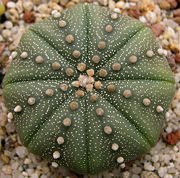Convergent evolution
| Convergent evolution |
|---|

|
|
These two succulent plant genera, Euphorbia |
Convergent evolution describes the acquisition of the same biological trait in unrelated lineages.
The wing is a classic example of convergent evolution in action. Although their last common ancestor did not have wings, birds and bats do, and are capable of powered flight. The wings are similar in construction, due to the physical constraints imposed upon wing shape. Similarity can also be explained by shared ancestry, as evolution can only work with what is already there - thus wings were modified from limbs, as evidenced by their bone structure.[1]
Similarity may also result if organisms occupy a similar ecological niches - that is, a distinctive way of life.[2] A classic comparison is between the marsupial fauna of Australia and the placental mammals of the Old World. The two lineages are clades - that is, they each share a common ancestor that belongs to their own group, and are more closely related to one another than to any other clade - but very similar forms evolved in each isolated population.[1] Many "body plans", for instance sabre-toothed cats and flying squirrels,[3]evolved independently in both populations.
Convergence also occurs in cultural evolution.
Traits arising through convergent evolution are termed analogous structures, in contrast to homologous structures, which have a common origin. Bat and pterodactyl wings are an example of analogous structures, while the bat wing is homologous to human and other mammal forearms, sharing an ancestral state despite serving different functions. Similarity due to convergent evolution, but independent origins is called Homoplasy. Similarity due to the common ancestor is called Homology and not due to convergent evolution.
The opposite of convergent evolution is divergent evolution, whereby related species evolve different traits. On a molecular level, this can happen due to random mutation unrelated to adaptive changes; see long branch attraction. Convergent evolution is similar to, but distinguishable from, the phenomena of evolutionary relay and parallel evolution. Evolutionary relay describes how independent species acquire similar characteristics through their evolution in similar ecosystems, at different times: for example the dorsal fins of extinct ichthyosaurs and sharks. Parallel evolution occurs when two independent species evolve together at the same time in the same ecospace and acquire similar characteristics - for instance extinct browsing-horses and paleotheres.
Significance
The degree to which convergence affects the products of evolution is the subject of a popular controversy. In his book "Wonderful Life", Steven Jay Gould argues that if the tape of life were re-wound and played back, life would have taken a very different course.[4] Simon Conway Morris counters this argument by arguing that convergence is a dominant force in evolution, and that since the same environmental and physical constraints act on all life, there is an "optimum" body plan which life will inevitably evolve towards, with evolution bound to stumble upon intelligence - a trait of primates, crows and dolphins - at some point.[1] Convergence is difficult to quantify, so there is no way to objectively resolve this argument.
Examples
-
For more details on this topic, see List of examples of convergent evolution.
One of the most famous examples of convergent evolution is the camera eye of cephalopods (e.g. squid) and vertebrates (e.g. mammals). Their last common ancestor had at most a very simple photoreceptive spot, but a range of processes led to the progressive refinement of this structure to the advanced camera eye - with one subtle difference; the cephalopod eye is "wired" in the opposite direction, with blood and nerve vessels entering from the back of the retina, rather than the front as in vertebrates.[1] The similarity of the structures in other respects, despite the complex nature of the organ, illustrates how there are some biological challenges (vision) that have an optimal solution. However, evolutionary history can act as a constraint, and most arthropods (eg insects) have a different form of eye, the compound eye. This is inferior to the camera eye in many respects, not least size and resolution.[5] Arthropods have failed to evolve a camera eye as there is no way of getting there without a decrease in vision quality, and evolution has no capacity of foresight or advance planning.
References
- ↑ 1.0 1.1 1.2 1.3 Conway Morris, Simon (2005), Life's solution: inevitable humans in a lonely universe, Cambridge, UK, doi:, ISBN 0521603250, OCLC 156902715
- ↑ Online Biology Glossary
- ↑ http://cas.bellarmine.edu/tietjen/Evolution/convergent_evolution_examples.htm
- ↑ Gould, S.J. (1989). Wonderful Life: The Burgess Shale and the Nature of History. W.W. Norton & Company.
- ↑ M F Land; R D Fernald (1992). "The Evolution of Eyes". Annual Review of Neuroscience 15: 1–29. doi:.
- Rasmussen, L.E.L., Lee, T.D., Roelofs, W.L., Zhang, A., Doyle Davies Jr, G. (1996). Insect pheromone in elephants. Nature. 379: 684
- Convergent Evolution Examples- Ecological Equivalents, Department of Biology, Bellarmine University
- Stearns, S. & Hoekstra, R. 2005. Evolution: An introduction.
|
||||||||
